

The high-performance full-frame Canon EOS 5DS R camera on the microscope
Is there any point at all in using a 50 megapixel camera for microscopy applications? As we had wanted to get to the bottom of this question for a while we ventured a test with the Canon EOS 5DS R.
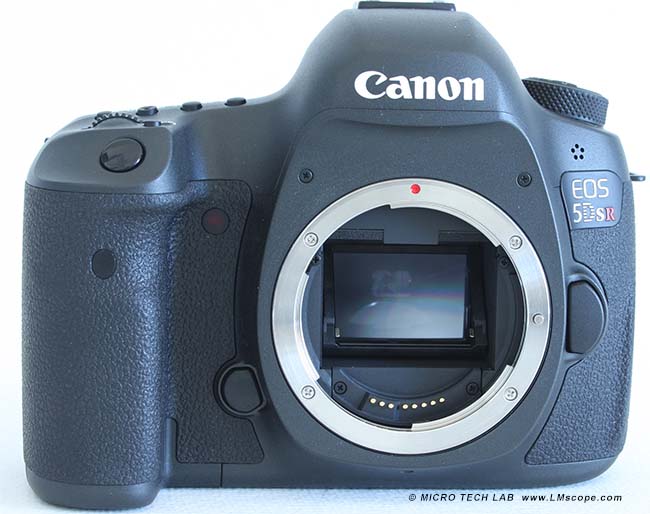
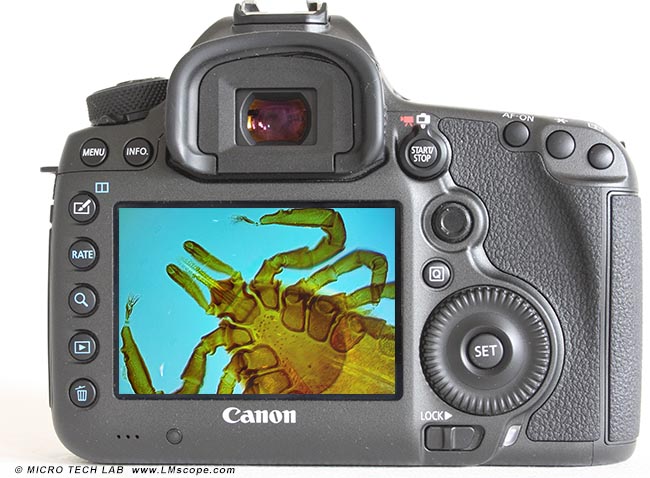
In terms of external appearance, the Canon EOS 5DS R is similar to the Canon EOS 5 D Mark III. The body is very robust (940 g) and feels comfortable in the hand. There is a 3.2" monitor on the rear, which unfortunately cannot be tilted or pivoted. The operating controls on the back are clearly laid out, and the buttons are well sized and shaped, especially for men’s hands.
ISO sensitivity can be adjusted automatically from 100 to 6,400 and manually from 50 to 12,800. The dynamic range is 12.4 EV.
Videos can be recorded in full HD, but unfortunately not in 4k (ultra HD). The maximum frame rate per second is 30 fps. Of course, Live View output is available via the HDMI port.
The mechanical shutter causes surprisingly little vibration. This makes it possible to set exposure times anywhere between 1/8,000 and 30 seconds.
The camera can be controlled remotely using the Canon Utility 3 software. It also works without a memory card, as captured images can be transferred directly to the PC.
From a user's standpoint, it is hard to understand why the camera does not have wireless connectivity. However, for our purposes in the studio and laboratory, built-in WiFi is not absolutely essential, as we use the USB cable connection anyway.
As already mentioned, the camera packs a whopping 50 megapixels. Theoretically, our microscopy applications require only a few megapixels, as the resolution of the image is limited by the numerical aperture of the microscope lenses. For this reason, the majority of C-mount cameras do not feature more than 10 megapixels. Accordingly, in purely physical terms, a camera offering a higher performance potential should not be able to yield a better image quality in photomicrography. However, as the whole is often more complex than the individual parts, we were really curious to see how things would work out with the Canon EOS 5DS R.
Colour cameras have a Bayer filter, which filters the primary colours of the incoming light natural colour images. In a lab or studio setting, a high resolution is needed to capture very fine details without seeing pixel structure or visual artifacts.
For our test shots we attached the Canon top model EOS 5DS R without low pass filter (even higher resolution) to the photo tube of a Zeiss microscope with an infinity-corrected optical system using our LM digital adapters.
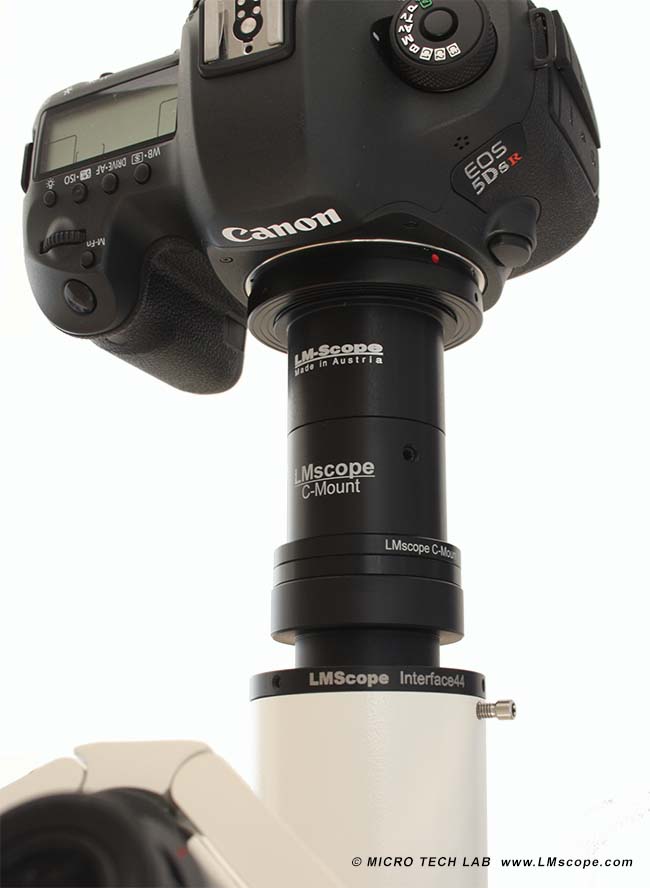
Our test specimen was a fruit fly (drosophila), specifically the wings. We used a Plan Neofluar 10x microscope objective and covered the fly with the LM UV-Matrix mounting medium.
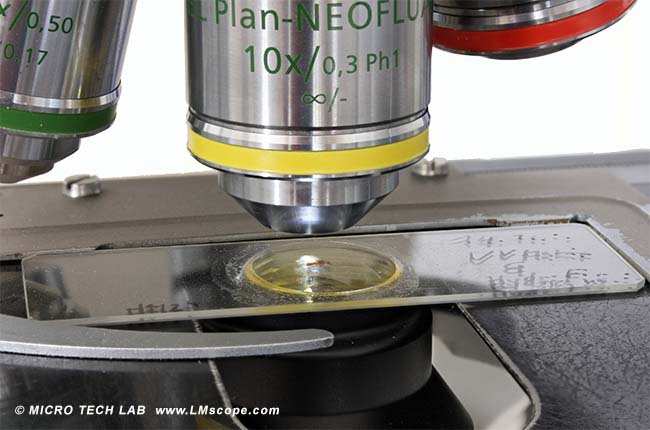
The camera itself was not controlled manually, but remotely via PC using the Canon Utility 3 software. The results were sensational! The resolution of the images is enormously high and they are also very rich in contrast. The HDR function on the Canon EOS 5DS R is also very useful: the camera takes a series of images, each with a different exposure, and then combines them into a single image with a high dynamic range. This feature is particularly interesting when dealing with heterogeneous specimens that do not have a uniform thickness, for example insects, where the body is thicker and the wings very thin.
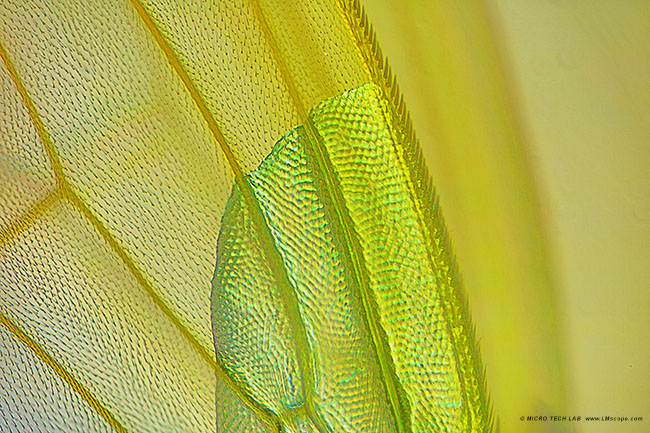
Conclusion:
The Canon EOS 5DS R is hands down the best camera that we have tested so far. It offers superlative sensor quality, an enormous dynamic range and an excellent signal-to-noise ratio. Even if it is not possible to fully utilise the 50 megapixels in photomicrography, the user still benefits from the extensive package of camera features. The HDR function in particular is an extremely handy tool. As an added bonus, it would be nice if it were possible to record 4k videos (ultra HD) with HDMI Live View output to an external monitor. We also recommend reading our report on the Canon EOS 5DS.
22.12.2015
New LM Digital Adapter for: Canon EOS R6 Mark II / Canon EOS R8 / Canon EOS R5 / Canon EOS R6 / Canon EOS R / Canon EOS Ra (Astro) / Canon EOS RP / Canon EOS R7 / Canon EOS R10 / Canon EOS 1D X Mark III / Canon EOS 1D X Mark II / Canon EOS R100 / Canon EOS 1D X / Canon EOS 90D / Canon EOS 5D Mark IV / Canon EOS 6D Mark II / Canon EOS M6 Mark II / Canon EOS 250D / Canon EOS 850D / Rebel T8i / Canon EOS 6D / Canon EOS M200 / Canon EOS 5DS R ( without low-pass filter) / Canon EOS 80D / Canon EOS M50 Mark II / Canon EOS 5DS / Canon EOS M50 / Canon EOS 70D / Canon EOS 200D / Canon EOS 800D / Rebel T7i / Canon EOS 77D /